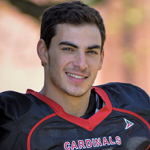AUTHOR ESSAY: Tales of Rhinestone Cowgirls
In Rodeo Queens and the American Dream (Public Affairs/Perseus Books, 2002), Joan Burbick ’76 chronicles the lives of white and Native American women who worked in professional rodeos in the Pacific Northwest from the 1930s to the 1990s. She talks about what she learned from listening to their stories.
I am now called a writer. Before, I was an academic. I find this opposition unsettling. Once in a while, I even laugh. Eight years ago, I began listening to and recording stories of white and Native American women whose lives were lifted, broken, and shaped by the rural West. These women had one thing in common. They had all been rodeo queens for professional rodeos in the Pacific Northwest. Each woman promoted her local rodeo in the Columbia River circuit, traveling sometimes more than 30 weekends a year, riding in Saturday morning parades down countless Main Streets, and charging at breakneck speed on her horse into arenas to pump up the crowd at the start of each event. Some were called “sweethearts of the rodeo” and feted as local celebrities; others were derided as “cowboy cheerleaders” or “buckle–bunnies,” lost souls celebrating extreme machismo.
Because stories are fragile, I started interviewing women who were queens in the 1930s and ended by talking with rodeo queen candidates at the 1997 Miss Rodeo America pageant in Las Vegas. But I was an academic and, by definition, was looked upon with suspicion by publishers and editors who believed such a person could not communicate past a small enclave of intellectuals. Even worse, some women I interviewed thought that I lived in another world or even planet, apart from the worries of hardscrabble ways. Would they have to change their language for me?
The challenge was in the language. Could I tell the story and have someone else listen and nod her head or frown and disagree? What would the words tell? I chose to try and find the language closer to what the women wanted to tell me. That was the language closer to the drift and fissures of the land on which they lived and often lost. I had to step out from behind my desk, my computer, and library cubicle to listen, watch, puzzle, reflect, and write with a new necessity— to try and make sense of my experiences talking with these women.
Was I successful? That, only readers can decide. Did I find the words that made me overnight into a writer? Maybe. But I felt the freedom of not having to write for a select group, reading the same books and fighting about these books in redundant familiarity. I felt language returning to me, a discarded toy of my childhood. A hint of music returned with the words.
I live in the rural West in a university town where people feel the pain of isolation from the rest of the world, and more so from each other. Only fundamentalist Christians claim the passion of belonging that others both envy and fear. This pain of isolation pushed me to look around. After all, I taught American studies to eager undergrads and grads who listened when I spun out my theories of American literature, popular culture, and, my favorite subject, American nationalism. Hadn’t I taught for years a course on women writers in the American West? What did my basketload of theories about America have to do with where I lived?
I remember sitting in my kitchen, reading the local morning newspaper. The headlines announced the annual rodeo was coming to town. Every September, the paper printed the photographs of the women who had been past queens of the show, more than 60 rodeo queens in all. A regular portrait gallery. The current queen had a special article on her love of Western tradition and how good a horsewoman she was. Every fall, I would pause over their faces, read the articles, and sip my coffee. But a few years ago, I stopped and asked a few basic questions: Who were these women, and what were their lives like? What could their stories tell us about the West and how it had changed over the 20th century? What could they tell us about the dogged persistence of frontier mythology in the United States? With that, I started on a long journey down the rodeo road that ended with Rodeo Queens and the American Dream. But not really. I still get phone calls and letters with more stories from the women I have talked with over the years, something else I might want to know about that they were hesitant to tell the first, second, or third time we talked.
Talking to these women, I found out that I knew little of how people growing up in rural communities had changed, adapted, or left the land. Some younger women had little if any sense of the ranching West. They knew the Hollywood West, saturated with slogans about cowboys. They celebrated what older women often saw as a sham: rodeos as nostalgia machines, pumping out a generic brand of frontier hoopla, a spectator sport for the masses, complete with cowboys and sometimes Indians. Did this story even need a teller? The promotional copy of this national narrative was hawked by TV, radio, movies, advertisements, brochures, souvenirs, Western wear stores, liquor sales, pickup truck slogans, cigarette ads, presidential candidates, presidents, chambers of commerce, restaurants, hotels, and bars. That story.
But most women’s lives pushed against this thick plastic face of frontier gaiety. They lived in the spaces in between the hoopla. Their stories were worth listening to and trying to understand. The challenge was to return to the language and face the words of these women, the sense of the land, its economic pitfalls, its relentless beauty, its tragic limits, and tell again what I had heard.
Joan Burbick is professor of English and American studies at Washington State University.

